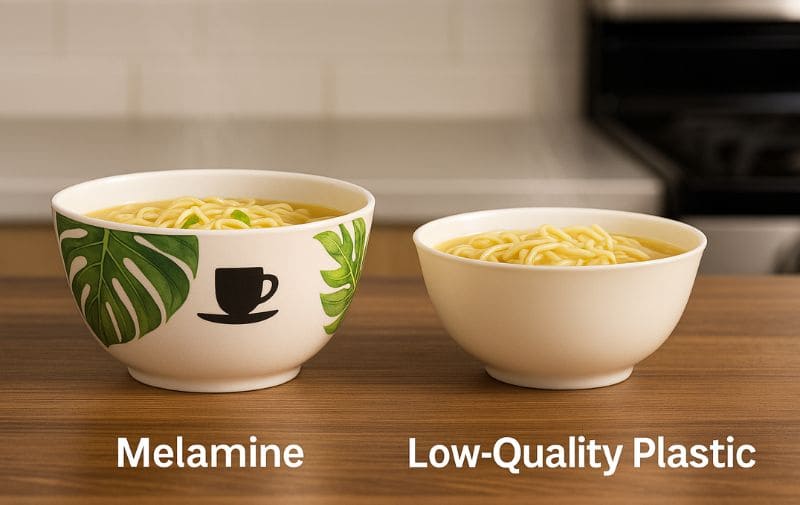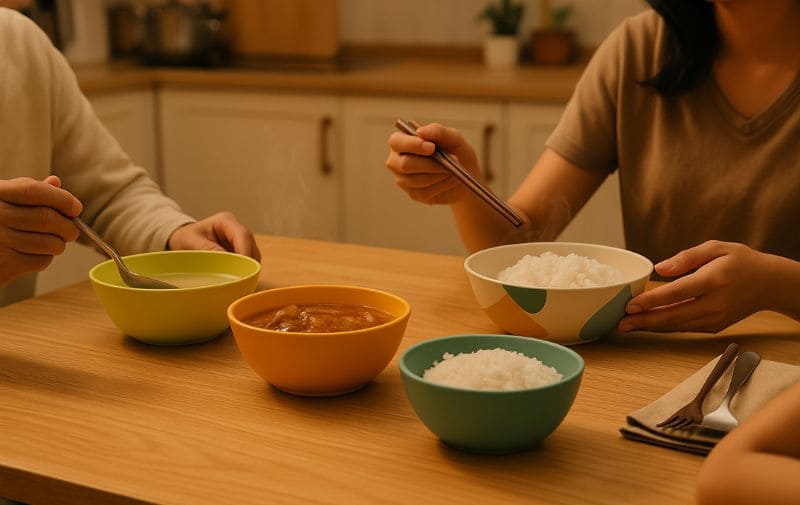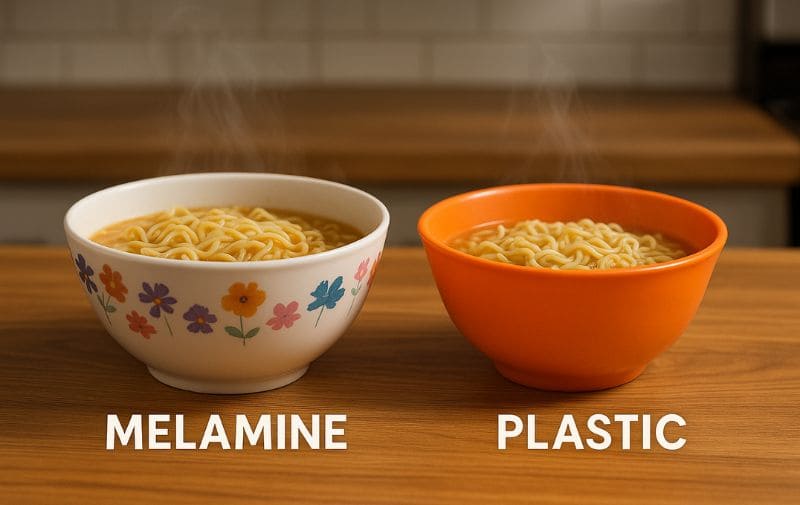Wondering if it’s safe to serve hot food in melamine bowls? The short answer is yes, with caveats. High-quality A5 grade melamine or bamboo fibre is designed for hot meals like soups and pasta, typically handling temperatures up to 70-100°C (158-212°F). This guide dives into the specifics, so you know exactly how to use your melamine bowls with hot food safely.
Last Updated: May 2025 | Estimated Reading Time: 5 minutes

Is it Generally Safe to Serve Hot Food in Melamine Bowls?
For the most part, yes, you can confidently serve hot food in melamine bowls. Quality melamine, especially A5 grade, is built for this. It’s why restaurants and cafeterias often rely on it for serving everything from steamy soups to freshly cooked pasta.
What do manufacturers generally advise about using melamine for hot food?
Reputable manufacturers of A5 grade (100% food-grade) melamine dinnerware state that their products are safe for serving hot foods. They design them to withstand typical serving temperatures. The key is serving hot food, not cooking or reheating food directly in melamine, as it’s not meant for ovens or microwaves. Always check specific manufacturer guidelines if available.
Why does melamine often stay cool to the touch even when holding hot food?
Melamine is a poor conductor of heat, meaning it doesn’t transfer heat easily. This is a fantastic insulating property. When you pour hot soup into melamine bowls, the bowl itself remains relatively cool on the outside. This makes it comfortable to handle, unlike ceramic or glass bowls that can get very hot. It’s a practical benefit, especially for children or when passing dishes around a table.
How does melamine’s insulating property affect food temperature?
Because melamine doesn’t absorb much heat from the food, it helps keep your hot meals warmer for a bit longer compared to more conductive materials. Your soup or stew will retain its temperature for a reasonable serving period, allowing you to enjoy your meal while it’s still pleasantly warm.

What Are the Temperature Limits for Hot Food in Melamine?
Understanding the melamine temperature limit is crucial for both safety and the longevity of your dinnerware. While it’s robust, it’s not invincible to extreme heat.
Is there a recommended maximum temperature for food served in melamine bowls?
Yes, most A5 grade melamine is rated safe for foods up to approximately 70°C (158°F) to 100°C (212°F) for short periods (serving time). This comfortably covers freshly served meals, including boiling water (100°C / 212°F), so ladling soup directly from a pot is generally fine. However, prolonged contact at the higher end of this range should be avoided.
Insider Tip: Some very high-quality formulations might tolerate slightly higher temperatures, but it’s always best to stay within the generally accepted range to be safe.
What happens if food hotter than 160°F (71°C) is placed in melamine for extended periods, or if temperatures exceed 212°F (100°C)?
If food significantly hotter than the recommended melamine temperature limit, especially beyond 100°C (212°F), is placed in melamine, or if it’s exposed to such heat for extended durations (not just typical serving times), a few things can happen:
- The material may begin to degrade over time.
- There’s a potential increase in the migration of melamine substances into the food.
- The bowl’s surface could become dull, discolored, or develop fine cracks prematurely.
Critical Distinction: A5 melamine (100% food-grade) offers the best heat resistance. Lower grades like A1 or A3 (often industrial grade or with fillers) have significantly lower heat tolerance and are not recommended for hot foods, posing a higher risk of degradation and chemical migration. Always opt for A5.
What Are the Concerns About Melamine Leaching into Hot Food?
The primary concern when discussing hot food in melamine bowls revolves around the potential for melamine compounds to migrate, or “leach,” from the dish into the food.
Can melamine leach from dishes into food when serving hot items?
Yes, under certain conditions, small amounts of melamine can leach into food. This is more likely if the food is highly acidic, if the melamine is of poor quality, if the surface is scratched or damaged, or if the food is significantly hotter than the recommended melamine safe temperature for food and remains in contact for a long time.
What did studies, like the one in JAMA Internal Medicine, find about melamine migration with hot soup?
A notable study published in JAMA Internal Medicine (2013) investigated melamine migration. Participants who consumed hot noodle soup (around 90°C / 194°F initially) from melamine bowls showed higher levels of melamine in their urine compared to those who used ceramic bowls.
- Key Finding: The study indicated that melamine migration does occur with hot foods, even with compliant dinnerware.
- Important Context: The levels detected were generally below the Tolerable Daily Intake (TDI) set by bodies like the World Health Organization (WHO) and the FDA for a single exposure. However, it highlights that repeated exposure from various sources should be considered.
The FDA’s safety and risk assessment of melamine states that it’s safe for serving food as long as food is not heated in melamine containers in the microwave, and not used for acidic foods for extended hot periods.

What are the potential risks if melamine degrades due to excessive heat?
If melamine is repeatedly exposed to heat beyond its melamine temperature limit, it can degrade. This degradation can:
- Increase the likelihood and amount of melamine and formaldehyde migration.
- Compromise the structural integrity of the bowl, making it brittle or warped.
- Lead to a dull or chalky surface, which can harbor bacteria and be harder to clean. While acute health effects from typical use of quality melamine are rare, long-term exposure to higher levels of migrated substances is a concern that regulatory bodies monitor.
How Does “High Heat” Affect Melamine Material Itself?
There’s a crucial difference between serving hot food and subjecting melamine to direct, intense heat sources.
Can melamine bowls warp or crack from contact with very hot food, similar to microwaving concerns?
Yes, if the “hot food” is extremely hot – for instance, sizzling oil directly from a deep fryer (often 180°C+/350°F+), or if a bowl is placed directly on a hot stovetop burner or in an oven – the melamine will be damaged. This can cause:
- Warping, making the bowl unstable.
- Blistering or charring of the surface.
- Cracking or shattering.
- Discoloration.
This damage occurs because the heat is far beyond the material’s melamine temperature limit and is often applied directly and unevenly.
Is there a difference between holding hot food and heating food in melamine?
Absolutely. This is a critical distinction.
- Holding/Serving Hot Food: Melamine is designed for this. The food transfers heat conductively. Good quality A5 melamine can handle typical serving temperatures.
- Heating Food in Melamine (e.g., Microwaving): This is a NO. Microwaves heat the melamine material itself, often unevenly and to very high temperatures, causing it to break down, potentially leach more chemicals, and damage the bowl. Melamine is a thermosetting plastic; it’s cured with heat, but that doesn’t mean it can withstand further, intense heating cycles like those in a microwave or oven.
Think of it this way: Melamine is for serving the hot food you’ve cooked in appropriate cookware (metal, glass, ceramic), not a cooking vessel itself.
📊 Melamine & Heat Interaction – Key Differences 📊
| Action | Melamine Suitability (A5 Grade) | Why? | Potential Outcome if Misused |
|---|---|---|---|
| 🍲 Serving hot soup (up to 100°C/212°F) | ✅ Safe | Designed for this, conductive heat transfer. | Generally safe. |
| 🔥 Placing on stovetop/oven/broiler | ❌ Unsafe | Direct, intense heat far exceeds material limits. | Warping, cracking, melting, leaching. |
| ♨️ Microwaving food in melamine | ❌ Unsafe | Melamine absorbs microwave energy, overheats, degrades. | Damage, leaching, safety risk. |
| 🍳 Pouring sizzling oil (>150°C) into it | ❌ Unsafe | Extreme temperature shock. | Damage, warping, leaching. |
What Are the Best Practices for Using Melamine Bowls with Hot Food Safely?
To ensure you’re using your melamine bowls with hot food safely and to maximize their lifespan, follow these simple guidelines.
Should you avoid certain ultra-high temperature foods in melamine?
Yes. Avoid direct contact with foods or liquids that are significantly above boiling point for extended periods. This primarily means:
- Sizzling oils straight from a deep fryer or very hot pan.
- Caramelized sugars or candies at their peak temperature.
- Anything heated directly on a flame or in an oven before being transferred. Stick to serving freshly cooked meals that are at typical eating temperatures.
What steps should you take if you suspect melamine contamination from your bowl?
If a melamine bowl ever emits a strong chemical smell when in contact with hot food, or if it appears visibly damaged (cracked, crazed, blistered, severely discolored), it’s best to:
- Stop using it immediately for food, especially hot or acidic foods.
- Consider if the food was too hot or if the bowl is very old or of questionable quality.
- Dispose of the damaged bowl responsibly. This is rare with high-quality A5 products used correctly, but it’s good to be aware.
How does placing melamine on the top-rack of a dishwasher relate to heat tolerance?
Most quality A5 melamine dinnerware is dishwasher safe, typically on the top rack.
- The heating element in dishwashers is usually at the bottom, so the top rack is slightly cooler.
- The water temperature in a dishwasher cycle (usually 50-70°C / 120-160°F) is generally within melamine’s tolerance for short washing periods.
- Avoid “sanitize” cycles or high-heat drying options if they exceed the manufacturer’s recommendations for your melamine, as this prolonged heat can still contribute to wear over time.
💡 Do’s and Don’ts for Hot Food in Melamine Bowls 💡
| Do 👍 | Don’t 👎 | Why It Matters |
|---|---|---|
| ✅ Use A5 grade (100% food-grade) melamine bowls. | ❌ Use old, cracked, or visibly damaged melamine bowls. | Quality & integrity ensure safety. |
| ✅ Serve hot foods like soups, stews, pasta (up to ~100°C/212°F). | ❌ Microwave food in melamine bowls. | Prevents material degradation and leaching. |
| ✅ Allow very hot (e.g., just fried) foods to cool slightly before serving. | ❌ Place melamine bowls in ovens, on stovetops, or under broilers. | Avoids direct, intense heat damage. |
| ✅ Wash on the top rack of the dishwasher (check manufacturer advice). | ❌ Use for foods significantly hotter than boiling point for long periods. | Protects against exceeding temperature limits. |
| ✅ Inspect bowls regularly for signs of wear. | ❌ Use melamine for deep frying or holding sizzling oils. | Extreme heat will damage melamine. |
Note on Bamboo Fiber Dinnerware: If you use bamboo fiber dinnerware, which often uses melamine as a binder, the same principles apply. Ensure the melamine binder is A5 food-grade and follow similar heat precautions.
So, What’s the Verdict on Hot Food in Melamine Bowls?
Based on current understanding and proper usage, here’s the bottom line.
When can melamine be considered safe for serving hot food?
Melamine bowls can be considered safe for serving hot food when:
- They are made from A5 grade (100% food-grade) melamine-formaldehyde resin.
- The food temperature does not exceed approximately 100°C (212°F) and is typically within normal serving temperatures.
- The bowls are not used for cooking, microwaving, or direct contact with extreme heat sources (ovens, stovetops).
- The bowls are in good condition (not cracked, crazed, or heavily scratched).
- Highly acidic foods are not stored in them at high temperatures for very prolonged periods.

Are there specific types of melamine (e.g., A5 grade) that are better for hot food?
Absolutely. A5 grade melamine is unequivocally the best and safest choice for contact with hot food. It has superior heat resistance, durability, and lower potential for chemical migration compared to:
- A1 or A3 Melamine: Often contain urea-formaldehyde or other fillers, have lower heat resistance, and are not recommended for prolonged or hot food contact. These are sometimes found in cheaper, lower-quality items and may not meet stringent food safety standards for hot use.
Investing in A5 grade from reputable manufacturers like Duramela ensures you are getting a product designed with food safety and performance for hot foods in mind.
🌡️ Quick Melamine Temperature Guide 🌡️
| Scenario | Temperature Range (Approx.) | A5 Melamine Suitability | Notes |
|---|---|---|---|
| ☕ Serving Hot Drinks (Coffee, Tea) | 85-95°C (185-203°F) | ✅ Safe | Well within limits for serving. |
| 🍲 Ladling Freshly Made Soup/Stew | 90-100°C (194-212°F) | ✅ Safe | Typical serving temperature, generally fine. |
| 🍝 Serving Hot Pasta/Rice Dishes | 70-85°C (158-185°F) | ✅ Safe | Ideal use case. |
| ♨️ Dishwasher Top Rack (Normal Cycle) | 50-70°C (120-160°F) | ✅ Generally Safe | Check manufacturer’s advice. Avoid high-heat dry. |
| 🔥 Food Directly from Frying Pan (Oil) | 150°C+ (300°F+) | ❌ Unsafe | Too hot, risk of damage and leaching. |
| ⚡ Microwaving | Variable, Can Exceed Limits | ❌ Unsafe | Melamine absorbs energy, degrades. |
| ♨️ Oven / Stovetop | Variable, High | ❌ Unsafe | Direct heat source, will damage material. |
Common Questions About Melamine and Hot Food
Q1: Can you put hot soup in melamine bowls without worry?
Yes, if it’s an A5 grade melamine bowl and the soup is at a normal serving temperature (up to boiling, 100°C/212°F), it’s generally safe for the duration of a meal. Avoid simmering soup in it for hours.
Q2: Does the color or pattern on melamine affect its safety with hot food?
No, the color or embedded decal in quality A5 melamine is protected by a clear, food-safe glazing layer. As long as this layer is intact and not damaged, it doesn’t impact safety with hot food.
Q3: How long can hot food stay in a melamine bowl?
For the typical duration of a meal (e.g., 30 minutes to an hour), it’s fine. Avoid storing hot food in melamine for many hours or overnight, especially if it’s acidic.
Q4: Is “BPA-Free” melamine automatically safe for all hot foods?
Melamine itself is chemically different from Bisphenol A (BPA). So, all true melamine is BPA-free. However, safety for hot foods still depends on the grade of melamine (A5 is crucial) and adherence to temperature limits.
Summary & Key Takeaways
Serving hot food in melamine bowls is generally safe and practical, provided you use high-quality A5 grade melamine and follow sensible guidelines. Remember that melamine is for serving, not cooking. Its excellent insulating properties and durability make it a great choice for everyday meals and entertaining.
By understanding the melamine temperature limit (typically up to 100°C/212°F for short periods) and avoiding direct high heat like microwaves or ovens, you can confidently enjoy the benefits of your melamine dinnerware with hot meals while ensuring its longevity and safety.
Recommended Internal & External Links:
- U.S. FDA – Melamine in Tableware Questions and Answers
- (Study Reference): JAMA Internal Medicine – Study on Melamine Migration from Tableware



